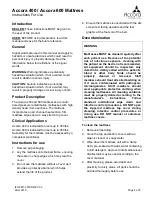
WARNING!
Risk of injury if the mobility device is driven
when ability to operate a vehicle is impaired by
medication or alcohol
– Never drive the mobility device under the
influence of medication or alcohol. If necessary,
the mobility device must be operated by an
attendant who is physically and mentally able.
WARNING!
Risk of damage or injury if mobility device is
accidentally set into motion
– Switch the mobility device off before you get
in, get out or handle unwieldy objects.
– When the drive is disengaged, the brake inside
the drive is deactivated. For this reason,
pushing the mobility device by an attendant
is only recommended on flat surfaces, never
on gradients. Never leave your mobility device
on a gradient with its motors disengaged.
Always re-engage the motors immediately after
pushing the mobility device (refer to Pushing
the mobility device in freewheel mode).
WARNING!
Risk of injury if the mobility device is switched
off while driving, for example by pressing the
On/Off Button or disconnecting a cable, due to
it coming to an abrupt, sharp stop
– If you have to brake in an emergency, simply
release the joystick which will bring you to a
halt (refer to the remote user manual for more
information).
WARNING!
Risk of injury when transferring mobility device
to a vehicle for transport with the occupant
seated in it
– It is always better to transfer the mobility
device to a vehicle without the occupant seated
in it.
– If the mobility device needs to be loaded up a
ramp together with its driver, ensure that the
ramp does not exceed the rated slope (refer to
).
– If the mobility device does need to be loaded
using a ramp which exceeds the rated slope
(refer to
), then you
must use a winch. An attendant can safely
monitor and assist the loading process.
– As an alternative you can use a platform lift.
Ensure that the total weight of the mobility
device including the user does not exceed the
maximum permissible weight for the platform
lift or winch if you are using.
1547067-H
9










































